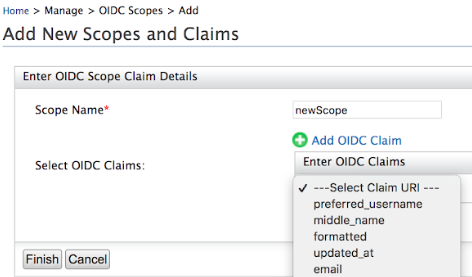OpenID Connect Scopes and Claims¶
The OpenID Connect specification includes a variety of scopes. Scopes are a form of delegated access control that specify the scope of an access request. From an OpenID Connect (OIDC) perspective, scopes allow an application to request for additional user details that are sent in the form of claims.
In WSO2 Identity Server, the mapping between scopes and claims are persisted in the database layer.
How does OpenID Connect scope-claim mapping work?¶
The default OIDC scope claim mappings can be found in the
<IS_HOME>/repository/conf/identity/oidc-scope-config.xml
file. In the very first server startup, scopes and claims defined in
this file are stored in the database and the same data is displayed in
the management console
UI.
When working with tenants, the data that is defined in the
aforementioned file is stored in the database against the tenant ID.
After the very first server start up and the tenant creation, any
changes made to the oidc-scope-config.xml file will
not have any effect. So adding, removing, and editing OIDC scopes should
be done through the management console UI from this point onwards.
Adding, editing, and viewing scopes¶
In the management console, the OIDC Scopes section can be viewed under Manage. Click Add to add a new scope mapping or click List to view a list of existing scopes.
- When adding scopes, you can assign claims to a scope by entering a
Scope Name and assigning an available OIDC claim to that scope
from the dropdown that appears once you click the Add OIDC Claim
button as indicated below. Click Finish to add the new scope
claim mapping.

- Listing the scopes can be done clicking on the List button. You
can add and remove claims from the scope by using the Add claims
and Update buttons respectively. You can also delete a scope
claim mapping.

Tip
To add custom claims to any OIDC scope:
- Add a custom claim to the local dialect,
https://wso2.org/claims - Add an external claim into the
http://wso2.org/oidc/claimdialect referring the local claim created in step1. - In the OIDC Scopes section, add the newly added OIDC claim under the desired scopes.
For a sample use case, see Handling Custom OIDC Claims.
Database structure for OIDC scope claim mapping¶
Two new tables and a new index have been introduced to persist scope claim mapping as indicated below.
Click to view table structure
CREATE TABLE IF NOT EXISTS IDN_OIDC_SCOPE (
ID INTEGER NOT NULL AUTO_INCREMENT,
NAME VARCHAR(255) NOT NULL,
TENANT_ID INTEGER DEFAULT -1,
PRIMARY KEY (ID)
);
CREATE TABLE IF NOT EXISTS IDN_OIDC_SCOPE_CLAIM_MAPPING (
ID INTEGER NOT NULL AUTO_INCREMENT,
SCOPE_ID INTEGER,
EXTERNAL_CLAIM_ID INTEGER,
PRIMARY KEY (ID),
FOREIGN KEY (SCOPE_ID) REFERENCES IDN_OIDC_SCOPE(ID) ON DELETE CASCADE,
FOREIGN KEY (EXTERNAL_CLAIM_ID) REFERENCES IDN_CLAIM(ID) ON DELETE CASCADE
);
CREATE INDEX IDX_AT_SI_ECI ON IDN_OIDC_SCOPE_CLAIM_MAPPING(SCOPE_ID, EXTERNAL_CLAIM_ID);